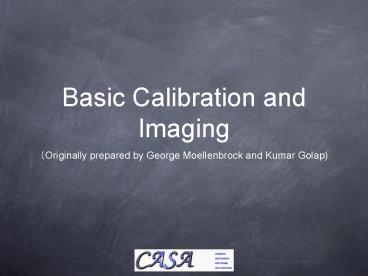Basic Calibration and Imaging - PowerPoint PPT Presentation
1 / 15
Title:
Basic Calibration and Imaging
Description:
The general synthesis calibration problem in the complex visibility ... Use orthogonality, timescales, field properties to separate. All terms mutually relative ... – PowerPoint PPT presentation
Number of Views:29
Avg rating:3.0/5.0
Title: Basic Calibration and Imaging
1
Basic Calibration and Imaging
- (Originally prepared by George Moellenbrock and
Kumar Golap)
2
CalibrationCalibration Principles
- See Appendix E of Cookbook
- The general synthesis calibration problem in the
complex visibility domain - Vobs MfMBGDPETF Vtrue A
- Vtrue the true, ideal visibilities FT(I)
- Vobs the observed, realistic visibilities
- Each complex calibration term corresponds to an
effect corrupting the observations e.g., for an
antenna-based term on baseline i-j - G Gij Gi x Gj
3
Calibration Principles (cont)
Vobs MfMBGDPETF Vtrue A
- Antenna-based terms
- F ionospheric Faraday rotation (TBD)
- T tropospheric effects (gaincal, opacity)
- E collecting area (gaincurve, mosaic)
- P parallactic angle (TBD, toolkit)
- D instrumental polarization (TBD, toolkit)
- G electronic gain (gaincal)
- B bandpass (bandpass)
- A additive noise, including RFI (TBD)
- Baseline-based terms (closure errors)
- M baseline-based gain (blcal)
- Mf baseline-based bandpass (blcal)
- A additive noise
- Right-most terms () may have direction-dependence
, and so become part of the visibility transform
4
Calibration Principles (cont)
- Calibration is the solution to a Matrix Equation
(Measurement Equation Hamaker, Bregman, and
Sault 1996) - The wavefront is a vector, after all!
- Scalar treatments instructive, sometimes
practical, but necessarily incomplete (and not
just for polarization!) - Terms do not mutually commute, in general
- Factorability of terms not formally assured
- Use orthogonality, timescales, field properties
to separate - All terms mutually relative
- Antenna-based terms preserve closure
- Bookkeeping solutions nominally per field, per
spectral window transfer among fields, spectral
windows, time is required
5
Calibration Principles (cont)
- Basic Calibration approach
- Choose calibrator fields containing sources of
known structure (usually points, if available) - Observe calibrators on appropriate timescales at
appropriate frequencies with sufficient
sensitivity for relevant calibration terms - Solve for relevant calibration terms in the
appropriate sequence - Apply derived calibration to science targets and
image - Self-calibrate, if possible/desired
6
Calibration in CASA
- The calibration solve is generic
- Vcorrected-obs J Vcorrupted-mod
- Vcorrected-obs partially corrected data
- Vcorrupted-mod partially corrupted model
- J the calibration term under consideration
for which the data used for solving is
appropriate - Every calibration solve is relative to the
current model and to whatever calibration is
already in hand - Solved-for term parameterized as needed
7
Basic Calibration Tasks
- setjy set the calibrator model visibilities
- gaincal solve for time-dependent generic
antenna-based gains - bandpass solve for channel-dependent
(antenna-based) gains - blcal solve for baseline-based gains
- plotcal plot calibration solutions (and flag
them) - fluxscale transfer flux density scale from
primary calibrator(s) - applycal apply calibration
8
Basic task parameters
- Dataset specification and data selection
- Solving parameters
- Apply parameters
9
Demo A simple VLA spectral line example
- NGC5921 HI with VLA
- One spectral window, total intensity only (RR and
LL) - Requires gain (G) and bandpass (B) calibration
only - Two calibrators 3C286 for flux density and
bandpass 1445099 for time-dependent gain - Basic Calibration equation
- Vobs BGVmod
- Plausible calibration heuristic
- 1. temporary G on 3C286 Vobs GVmod
- 2. B on 3C286, using G Vobs B(GVmod )
- 3. G on both, using B (B-1Vobs) GVmod
- 4. fluxscale on G
- 5. Apply to NGC5921 Vcor G-1B-1Vobs
10
2. Imaging
- Use clean
- clean(vis"ngc5921_src.split.ms",imagename"ngc592
1_task",mode"velocity",alg"hogbom",niter6000,ga
in0.1,threshold"8.0mJy" , mask"",cleanbox,nc
han38,start"1595km/s",width1,step"-5.5km/s",im
size256, 256,cell15.0, 15.0,stokes"I",field
"0",spw"",weighting"briggs",rmode"norm",robust
0.5) - Use invert and deconvolve
- invert(vis'ngc5921_src.split.ms',imagename'ngc59
21_invert', mode'velocity',nchan38,start'1595km
/s',step'-5.5km/s',field'0',imsize256,256,cel
l15.,15.,weighting'briggs',rmode'norm',robust
0.5) - deconvolve(imagename"ngc5921_invert.dirty",model
"ngc5921_decon",psf"ngc5921_invert.beam",alg"hog
bom",niter6000,gain0.1,threshold"8.0mJy")
11
The difference
12
Imaging tasks
- see Chapter 5 of Cookbook
- Invert
- deconvolve
- clean
- single-field cleaning, variety of algorithms
- mosaic
- For multi-field data, uses mosaic uv-gridder
(uv-plane mosaicing on single image) - feather - combine single-dish and uvMS
- widefield
13
Some useful parameters
- phasecenter
- phasecenter'5' field id 5
- phasecenter'J2000 19h30m25.6 -20d30m00.5'
- restfreq (rest frequency for velocity)
- restfreq'1.420GHz'
- 'Interactive' clean
- cleanbox'interactive'
14
Demo imaging
- NGC5921 HI with VLA
- calibrated data in the previous demo
15
Exercises (calibration)
- Verify suggested NGC5921 calibration heuristic
- Attempt alternative heuristics, e.g.,
- Vary solution intervals
- G then B (no G with B)
- B(t) only (use 1445099 flux density from above)
- Explore G vs. T heuristics with Jupiter data
- Compare results using plotcal/plotxy































